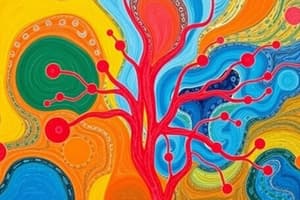Podcast
Questions and Answers
What effect does the deflection of stereocilia towards the kinocilium have on the hair cell physiology?
What effect does the deflection of stereocilia towards the kinocilium have on the hair cell physiology?
- It prevents the release of neurotransmitters.
- It causes hyperpolarization of the cell.
- It opens voltage-gated calcium channels, resulting in depolarization. (correct)
- It leads to an increase in potassium ion efflux.
Which ion is more abundant in endolymph compared to perilymph?
Which ion is more abundant in endolymph compared to perilymph?
- Sodium ions (Na+)
- Calcium ions (Ca2+)
- Potassium ions (K+) (correct)
- Chloride ions (Cl-)
What occurs when hair cells experience hyperpolarization?
What occurs when hair cells experience hyperpolarization?
- Calcium channels remain open.
- Potassium channels close.
- The rate of neurotransmitter release decreases. (correct)
- The firing rate of the afferent fibers increases.
How many semicircular canals are located on each side of the head?
How many semicircular canals are located on each side of the head?
What happens when the stimulation of hair cells ceases?
What happens when the stimulation of hair cells ceases?
What is the primary function of the vestibular system?
What is the primary function of the vestibular system?
Which structures are part of the vestibular system?
Which structures are part of the vestibular system?
What causes depolarization in vestibular hair cells?
What causes depolarization in vestibular hair cells?
How does hyperpolarization affect vestibular hair cells?
How does hyperpolarization affect vestibular hair cells?
What role do the otolith organs play in the vestibular system?
What role do the otolith organs play in the vestibular system?
What happens to the hair cells during motion in one direction?
What happens to the hair cells during motion in one direction?
What causes the spontaneous activity of afferent neurons in the vestibular system at rest?
What causes the spontaneous activity of afferent neurons in the vestibular system at rest?
What condition is commonly associated with dysfunctions of the vestibular system?
What condition is commonly associated with dysfunctions of the vestibular system?
What is the primary role of the semicircular canals?
What is the primary role of the semicircular canals?
Which fluid is contained within the membranous canal of the semicircular canals?
Which fluid is contained within the membranous canal of the semicircular canals?
What is the function of the crista ampullaris within the ampulla of the semicircular canals?
What is the function of the crista ampullaris within the ampulla of the semicircular canals?
How do coplanar canals function during angular movement?
How do coplanar canals function during angular movement?
Which of the following can affect both hearing and balance?
Which of the following can affect both hearing and balance?
What does hair cell movement towards the kinocilium cause?
What does hair cell movement towards the kinocilium cause?
How are the auditory and vestibular systems similar?
How are the auditory and vestibular systems similar?
What characterizes the perilymph between the membranous and bony canals?
What characterizes the perilymph between the membranous and bony canals?
What is the orientation of the utricle and saccule with respect to gravity?
What is the orientation of the utricle and saccule with respect to gravity?
What do otolith organs primarily provide information about?
What do otolith organs primarily provide information about?
What is the function of the otoliths embedded in the macula?
What is the function of the otoliths embedded in the macula?
How are the hair cells within the utricle and saccule oriented relative to the striola?
How are the hair cells within the utricle and saccule oriented relative to the striola?
What is a key similarity between otolith organs and semicircular canals?
What is a key similarity between otolith organs and semicircular canals?
What does the motion of otolith crystals toward the kinocilium lead to?
What does the motion of otolith crystals toward the kinocilium lead to?
What effect does the structure of the striola have on the otolith organs?
What effect does the structure of the striola have on the otolith organs?
What is the approximate length of otolith crystals in humans?
What is the approximate length of otolith crystals in humans?
Flashcards
Vestibular System Function
Vestibular System Function
The vestibular system senses head motion, maintains posture, and stabilizes vision during head movement.
Vestibular Hair Cells
Vestibular Hair Cells
Sensory cells in the inner ear that detect head movement by detecting hair bundle deflection.
Hair Cell Depolarization
Hair Cell Depolarization
Occurs when stereocilia move towards the kinocilium, increasing neurotransmitter release.
Hair Cell Hyperpolarization
Hair Cell Hyperpolarization
Signup and view all the flashcards
Semicircular Canals
Semicircular Canals
Signup and view all the flashcards
Otolith Organs
Otolith Organs
Signup and view all the flashcards
Vestibular Afferents
Vestibular Afferents
Signup and view all the flashcards
Spontaneous Activity in Afferents
Spontaneous Activity in Afferents
Signup and view all the flashcards
Vestibular Hair Cell Depolarization
Vestibular Hair Cell Depolarization
Signup and view all the flashcards
Vestibular Hair Cell Hyperpolarization
Vestibular Hair Cell Hyperpolarization
Signup and view all the flashcards
Semicircular Canals Orientation
Semicircular Canals Orientation
Signup and view all the flashcards
Hair Cell Firing Rate Increase
Hair Cell Firing Rate Increase
Signup and view all the flashcards
Hair Cell Firing Rate Decrease
Hair Cell Firing Rate Decrease
Signup and view all the flashcards
Utricle orientation
Utricle orientation
Signup and view all the flashcards
Saccule orientation
Saccule orientation
Signup and view all the flashcards
Otolith function
Otolith function
Signup and view all the flashcards
Otolith structure
Otolith structure
Signup and view all the flashcards
Hair cell orientation in utricle
Hair cell orientation in utricle
Signup and view all the flashcards
Hair cell orientation in saccule
Hair cell orientation in saccule
Signup and view all the flashcards
Striola's function
Striola's function
Signup and view all the flashcards
Otolith vs. semicircular canals
Otolith vs. semicircular canals
Signup and view all the flashcards
What's the main fluid in the semicircular canals?
What's the main fluid in the semicircular canals?
Signup and view all the flashcards
What fluid surrounds the membranous canal?
What fluid surrounds the membranous canal?
Signup and view all the flashcards
What happens in the ampulla?
What happens in the ampulla?
Signup and view all the flashcards
How does endolymph movement affect hair cells?
How does endolymph movement affect hair cells?
Signup and view all the flashcards
How are semicircular canals functionally paired?
How are semicircular canals functionally paired?
Signup and view all the flashcards
How are auditory and vestibular systems similar?
How are auditory and vestibular systems similar?
Signup and view all the flashcards
What happens if the membranous labyrinth is damaged?
What happens if the membranous labyrinth is damaged?
Signup and view all the flashcards
How do hair cells in auditory and vestibular systems work?
How do hair cells in auditory and vestibular systems work?
Signup and view all the flashcards
Study Notes
Lecture 26: Vestibular System
- The vestibular system is responsible for sensing motion, posture, and image stabilization during head movement.
- Vestibular receptors are located within the inner ear labyrinth.
- The system is composed of otolith organs (saccule and utricle) and semicircular canals.
Topics
- Vestibular hair cells
- Semicircular canals
- Otolith organs
Overview
- The vestibular system senses motion, postural stability, and image stabilization during head movement.
- Receptors in the inner ear labyrinth provide information about head motion and orientation relative to gravity.
- The system assists in coordinating body position with other sensory information.
Vestibular Hair Cells
- Motion is detected by hair cells (kinocilium and stereocilia) in the vestibular organs.
- Deflection of these hairs causes hyperpolarization or depolarization depending on the direction of deflection.
- Depolarization is caused by stereocilia movement towards the kinocilium.
- Hyperpolarization is caused by stereocilia movement away from the kinocilium.
- Different polarization affects the primary vestibular afferent firing rate to the brainstem.
- Spontaneous activity at rest is due to open Ca²⁺ channels, causing a constant neurotransmitter release.
- Motion in one direction stimulates firing, while the opposite direction inhibits firing of the cranial 8th nerve.
Semicircular Canals
- Each canal is designed to detect angular acceleration during head rotation.
- The membranous canal is within a bony canal, filled with endolymph (high K⁺, low Na⁺).
- The space between the membranous and bony canals is filled with perilymph (low K⁺, high Na⁺).
- Hair cells inside the ampulla are located within a gelatinous structure called the cupula.
- Endolymph motion caused by angular head motion results in cupula deflection, which causes stereocilia movement towards or away from the kinocilium.
- Motion generates differences in transmitter release and discharge rates in the afferent nerves, proportional to the angular velocity.
- Semicircular canals are functionally paired, with opposite canals acting as push-pull pairs, one exciting and the other inhibiting.
Otolith Organs (Utricle and Saccule)
- These organs provide information about linear acceleration and changes in head position relative to gravity.
- The utricle lies horizontally, and the saccule is oriented vertically.
- Hair cells (macula) within the utricle and saccule have cilia embedded in a gelatinous mass containing calcium carbonate crystals (otoliths).
- Otoliths move due to gravity or acceleration, and cause a shear force on the stereocilia.
- This shear force leads to depolarization (and excitation) or hyperpolarization (inhibition) in the hair cells.
- The striola is the central stripe dividing the macula into regions of opposing hair cell polarity (towards or away).
- Otolith organs are sensitive to linear motion due to the striola's curvature.
- In contrast, semicircular canal hair cells sense motion in the same direction.
Similarities between the auditory and vestibular systems
- Both systems use a common fluid system (membranous labyrinth).
- Both involve hair cell motion detectors with similar principles.
- Both are innervated by branches of the same cranial nerve (8th).
Summary
- Specialized receptors (otolith organs and semicircular canals) within the inner ear detect forces related to head movement and gravity.
- Motion is detected by vestibular sensory organs through the deflection of hair cells.
- Motion causes changes in the electrical potential, transmitter release, and firing rates.
- Hair cells in semicircular canals are oriented in the same direction.
- Hair cells within otolith organs demonstrate opposing orientations to detect opposing directions of motion and acceleration.
- Vestibular and auditory systems share a common fluid system, hair cell detectors, and innervation.
Studying That Suits You
Use AI to generate personalized quizzes and flashcards to suit your learning preferences.




